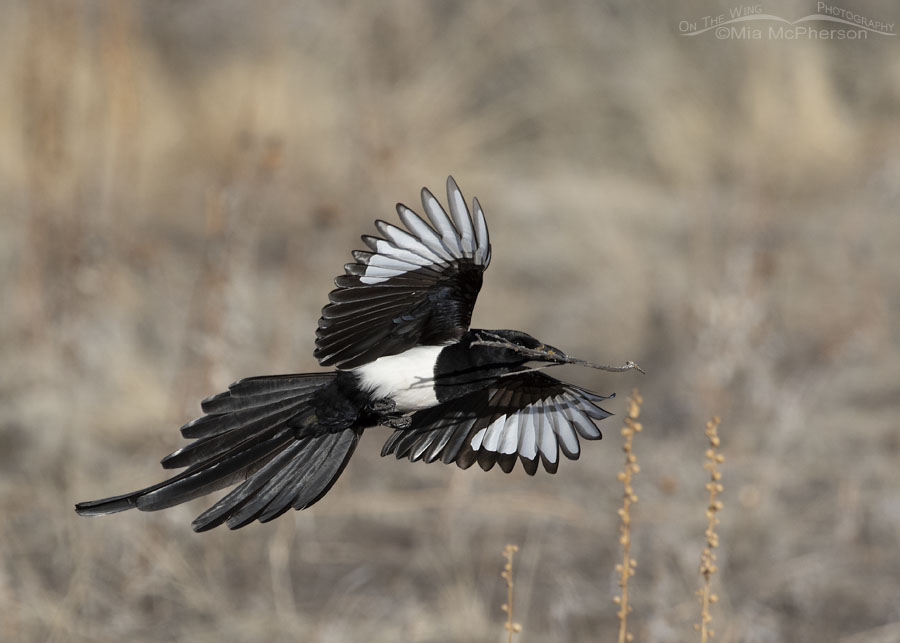 Black-billed Magpie adult flying toward nest with nesting material – Nikon D500, f6.3, 1/4000, ISO 500, Nikkor 500mm VR, natural light
Black-billed Magpie adult flying toward nest with nesting material – Nikon D500, f6.3, 1/4000, ISO 500, Nikkor 500mm VR, natural light
A little history about this nest:
The first time I photographed nesting Black-billed Magpies was on March 11, 2010. Had I not been observant to the birds around me on Antelope Island that day I might have missed out on some great opportunities with these magpies and this particular nest.
That morning I noticed a Black-billed Magpie in flight and it appeared to have something in its bill. Then I saw it land on a greasewood and disappear inside the branches. I wondered about it for a few seconds then saw the bird leave the greasewood and it didn’t look at all like it had anything in its bill. Then I saw another magpie fly into the greasewood with a small twig in its bill.
After carefully getting closer I was able to verify that my observations were correct, the magpies were constructing a nest in the greasewood. If I had not been paying attention to the first magpie’s activity and behavior I may have missed out on many opportunities to photograph these birds and their nesting behaviors over the next decade.
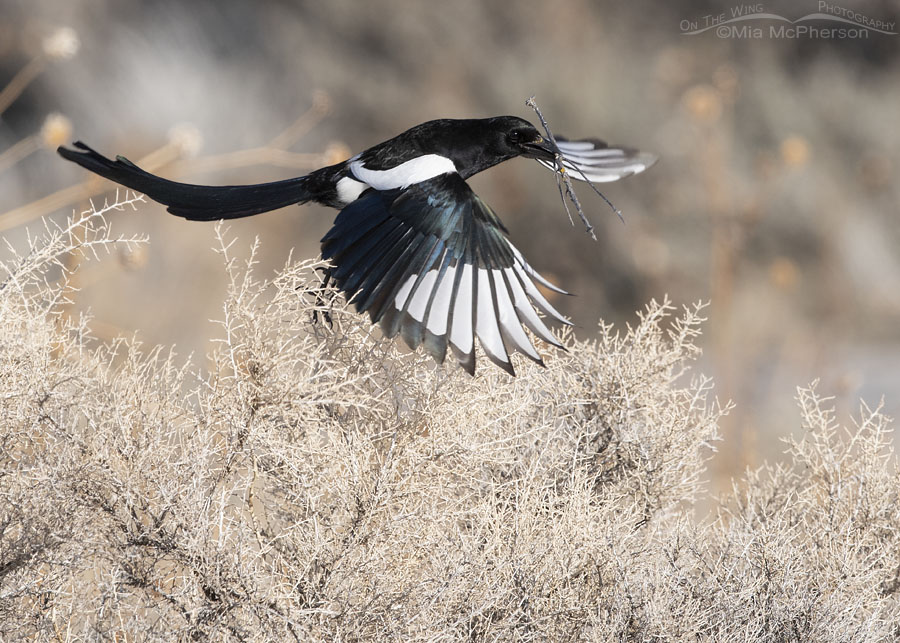 Adult Black-billed Magpie lifting off from a bush with nesting material – Nikon D500, f6.3, 1/4000, ISO 500, +0.7 EV, Nikkor 500mm VR, natural light
Adult Black-billed Magpie lifting off from a bush with nesting material – Nikon D500, f6.3, 1/4000, ISO 500, +0.7 EV, Nikkor 500mm VR, natural light
For ten years I have watched and photographed Black-billed Magpies nesting in the same greasewood. There have been a few years where they worked on this nest early in the season but then appeared to have actually nested somewhere else. I’ve never been fortunate enough to see their fledglings leave the nest but I have been able to photograph juvenile magpies nearby so I believe I may have photographed the young that were hatched in this nest.
By keeping a respectful distance, using a long lens and utilizing a vehicle as a mobile blind it is possible to photograph Black-billed Magpies building their nests without disrupting the process or negatively impacting their natural behavior.
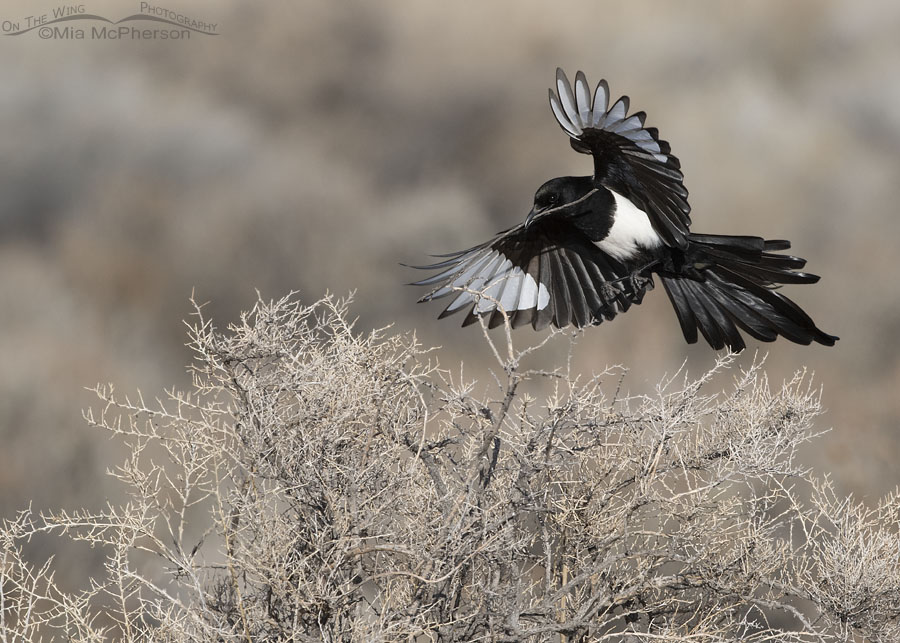 Black-billed Magpie about to land with nesting materials – Nikon D500, f6.3, 1/4000, ISO 500, Nikkor 500mm VR, natural light
Black-billed Magpie about to land with nesting materials – Nikon D500, f6.3, 1/4000, ISO 500, Nikkor 500mm VR, natural light
Around February these striking black and white magpies with with their shimmering green, blue and purple iridescent wing and tail feathers start to do nest building and maintenance to this nest by bringing in twigs and carefully placing them where the birds think they are needed. During the late winter the greasewood is bare, bright and not terribly attractive.
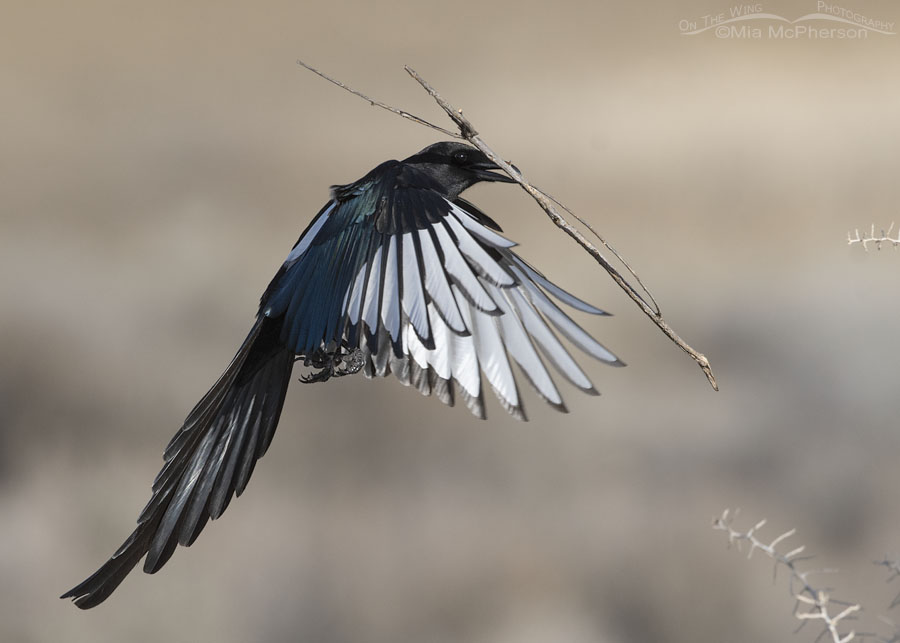 Black-billed Magpie with nesting material close up – Nikon D500, f6.3, 1/3200, ISO 500, Nikkor 500mm VR, natural light
Black-billed Magpie with nesting material close up – Nikon D500, f6.3, 1/3200, ISO 500, Nikkor 500mm VR, natural light
I try to photograph the Black-billed Magpies in flight with the nesting materials prior to landing on the greasewood because it is unattractive. Photographing the magpies in flight is challenging because their flight pattern isn’t always predictable and their black and white plumage is always tough when it comes to exposure settings.
Also, finding the right angle of light is important when it comes to being able to photograph the purple, green and blue iridescent tail and wing feathers.
Black-billed Magpie nest construction and/or maintenance takes approximately 40-50 days which has allowed me time to photograph these interesting, loud and fun birds over the years.
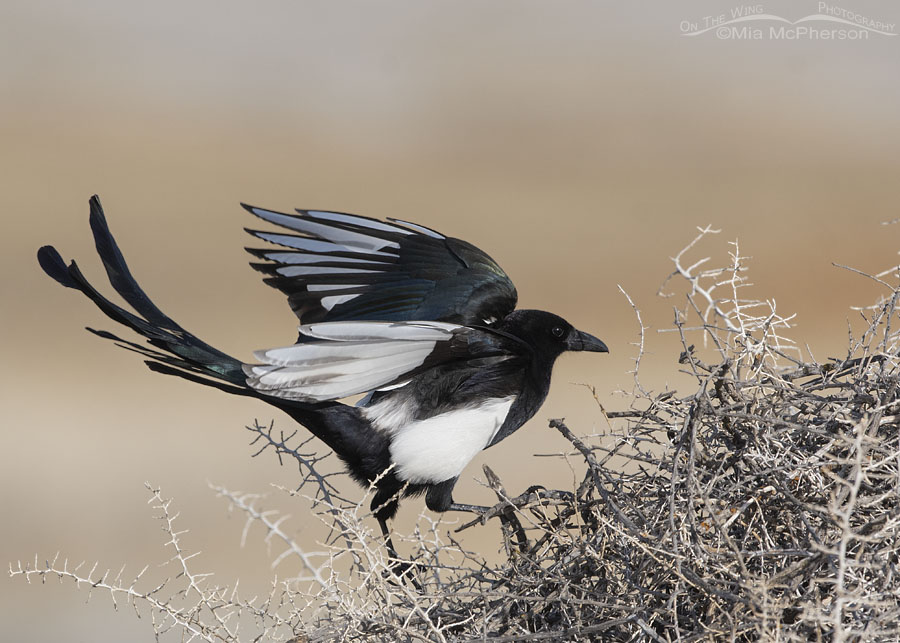 Adult Black-billed Magpie fluttering its wings on its nest – Nikon D500, f6.3, 1/2000, ISO 500, +0.7 EV, Nikkor 500mm VR, natural light
Adult Black-billed Magpie fluttering its wings on its nest – Nikon D500, f6.3, 1/2000, ISO 500, +0.7 EV, Nikkor 500mm VR, natural light
I wonder how many chicks have fledged from this nest. I wonder if the birds I am seeing nesting there now are the same adults or perhaps chicks that fledged from it. I also wonder how many more years this nest will be used. I can’t help but wonder.
I am more than thrilled to once again observe and photograph nesting Black-billed Magpies using the same greasewood where I first photographed them almost ten years ago. They have brought me so much joy.
Life is good.
Mia
Click here to see more of my Black-billed Magpie photos plus facts and information about this species.
Ethics on photographing nesting birds:
- Do not approach too closely
- If the birds show any sign of distress, back away
- Don’t trim leaves, twigs or branches to get a clearer shot, you may inadvertently attract predators or cause the eggs/chicks to over heat
- Follow local, state and federal guidelines concerning nesting birds
- Don’t harass the birds to get an action shot
- Don’t stay a long time with nesting birds or chicks, that disrupts their normal behavior
- Always remember that your scent may draw predators to the area of nesting birds or birds with chicks.
For more information on the ethics of photographing nesting birds or chicks check out the Principles of Birding Ethics published by the American Birding Association.


Great series of pics that took me down memory lane. Some years ago we had a small ranch in Northern Calif., and there were always a ton of magpies around. They were noisy, but fun to watch, and my kids loved listening to them “talk”. I later found out that Magpies are considered one of the most intelligent of all bird species. Which surprised me because I always thought that distinction belonged to crows. Live and learn right? Anyway, I love the shots. Thanks Mia.
We will look forward to seeing those babies!
Beautiful Magpie shots. It’s great to think that the same nest is being used year after year. 🙂
Beautiful, beautiful captures. Many thanks.
PS: What has happened to the ‘save name’ option?
Thank you EC.
I have never had the “save name” option on my site, it just does it automatically. Did you have to fill everything out again?
Yes, and have had to for the better part of a week now, including for this comment despite having just left another..
Thanks for letting me know EC, I will have to check into this.
EC, I found out how to turn on the “save my name” setting, let me know if that saves the info.
Thank you.
I will use it and have my fingers crossed for tomorrow.
Thanks EC
Awesome captures Mia. I so look forward to your “good eye” . Thanks for sharing.
Thank you Diane.
Very lovely, it would be nice to know if it is the same birds.
Thanks April, I wish there was a way of knowing.
Wow, fantastic!
Thank you Ian!
Very impressive series of images of a bird that is difficult to photograph.
Thanks Dave!